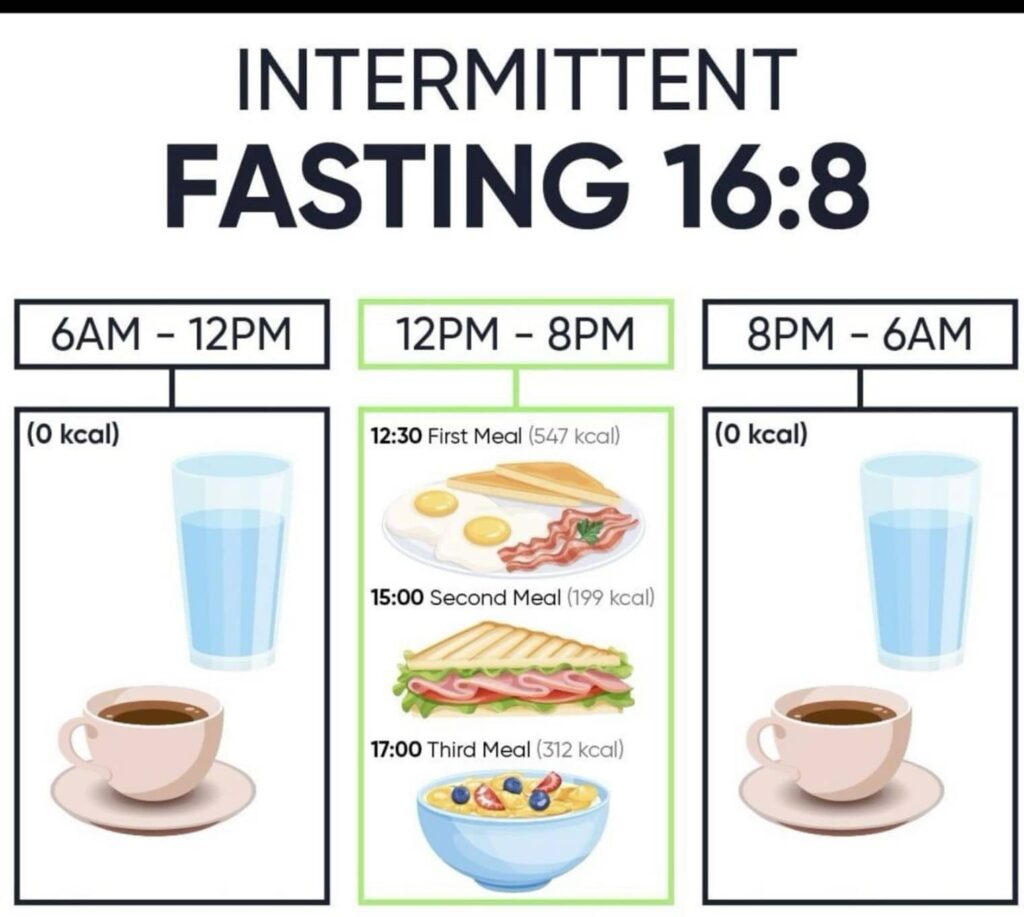Intermittent fasting has gained significant popularity in recent years as a effective way to improve health, manage weight, and enhance overall well-being. One of the most popular methods is the 16:8 intermittent fasting plan. This article will provide a detailed guide to the 16:8 fasting method, including its benefits, how to implement it, and tips for success.
What is Intermittent Fasting 16:8?
The 16:8 intermittent fasting method involves fasting for 16 hours each day and eating all your meals within an 8-hour window. This approach is flexible and can be adapted to fit your lifestyle. For example, you might choose to eat between 12 PM and 8 PM, fasting from 8 PM to 12 PM the next day.
Benefits of Intermittent Fasting 16:8
1. Weight Loss and Fat Loss:
Intermittent fasting can help you lose weight by reducing your overall calorie intake and increasing fat burning. During the fasting period, your body uses stored fat for energy.
2. Improved Insulin Sensitivity:
Fasting can improve insulin sensitivity, helping to regulate blood sugar levels and reduce the risk of type 2 diabetes.
3. Enhanced Brain Function:
Intermittent fasting has been shown to support brain health by promoting the production of brain-derived neurotrophic factor (BDNF), which supports cognitive function and mental clarity.
4. Cellular Repair and Autophagy:
Fasting triggers autophagy, a process where cells remove damaged components and recycle them for energy. This can promote cellular repair and longevity.
5. Simplified Eating Routine:
Having a defined eating window can simplify your daily routine, reducing the need for constant meal planning and snacking.
How to Implement the 16:8 Intermittent Fasting Plan
Sample Schedule:
- 6 AM – 12 PM: Fasting Period (0 kcal)
- 12:30 PM: First Meal (547 kcal)
- 3:00 PM: Second Meal (199 kcal)
- 5:00 PM: Third Meal (312 kcal)
- 8 PM – 6 AM: Fasting Period (0 kcal)
First Meal (12:30 PM):
Example Meal:
- Grilled Chicken Salad with Mixed Greens, Cherry Tomatoes, Cucumbers, and Olive Oil Dressing (547 kcal)
- Tips: Include a source of lean protein, healthy fats, and plenty of vegetables to keep you full and satisfied.
Second Meal (3:00 PM):
Example Meal:
- Greek Yogurt with Mixed Berries and a Sprinkle of Chia Seeds (199 kcal)
- Tips: Choose plain Greek yogurt to avoid added sugars. Berries add natural sweetness and antioxidants.
Third Meal (5:00 PM):
Example Meal:
- Baked Salmon with Steamed Broccoli and Quinoa (312 kcal)
- Tips: Salmon provides omega-3 fatty acids, while quinoa and broccoli offer fiber and essential nutrients.
Tips for Success with Intermittent Fasting 16:8
1. Stay Hydrated:
Drink plenty of water throughout the day, especially during the fasting period. Herbal teas and black coffee are also good options.
2. Eat Nutrient-Dense Foods:
Focus on whole, nutrient-dense foods during your eating window to ensure you’re getting the necessary vitamins and minerals.
3. Listen to Your Body:
Pay attention to hunger and fullness cues. If you feel overly hungry, consider adjusting your eating window or meal sizes.
4. Start Gradually:
If you’re new to fasting, start with a shorter fasting period and gradually increase it to 16 hours.
5. Stay Consistent:
Consistency is key to seeing results. Stick to your fasting and eating windows as closely as possible.
6. Exercise Wisely:
Incorporate light to moderate exercise during your fasting period. Save intense workouts for your eating window when you have more energy.
Common Challenges and How to Overcome Them
1. Hunger Pangs:
- Solution: Stay hydrated and busy. Hunger pangs often subside after the first few days as your body adjusts.
2. Social Situations:
- Solution: Plan ahead. If you have a social event, adjust your eating window to accommodate it.
3. Energy Dips:
- Solution: Ensure your meals are balanced with protein, healthy fats, and complex carbs to maintain energy levels.
4. Cravings:
- Solution: Keep healthy snacks on hand during your eating window to satisfy cravings without derailing your diet.
Conclusion
The 16:8 intermittent fasting method is a flexible and effective way to improve your health, manage weight, and simplify your eating routine. By following the tips and sample schedule provided in this guide, you can successfully implement this fasting method into your lifestyle. Remember, consistency and listening to your body are key to achieving the best results.
Start your intermittent fasting journey today and experience the numerous benefits it has to offer. Happy fasting!
By following this comprehensive guide, you’ll be well on your way to mastering the 16:8 intermittent fasting method and enjoying a healthier, more balanced lifestyle. Remember, the key to success is consistency and making adjustments as needed to fit your individual needs and preferences.










